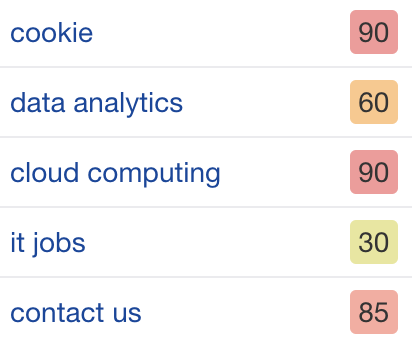
How to Leverage Keyword Metrics and Improve SEO Ranking
Author: Kysha Praciak
· 5 mins readIn the realm of search engine optimization (SEO), your strategy hinges on the smart use of keyword metrics. Understanding how to leverage these metrics can significantly enhance your SEO ranking, guiding which pages on your site are optimized for specific keywords. Google’s approach to ranking pages based on relevancy to the target keywords underscores the need for your content to meet search intent. By mastering keyword research and implementing effective keyword mapping, you ensure that each page is finely tuned to the nuances of SEO, avoiding the pitfalls of keyword cannibalization while aligning with users’ search queries.
The crux of improving your website’s visibility and driving targeted traffic lies in a multifaceted approach to SEO. This article will explore the integral components such as keyword search volume, keyword difficulty, organic traffic estimations, and cost-per-click (CPC). By dissecting these elements, you’ll gain insights into conducting competitive analysis and refining your SEO strategies. Each section is designed to equip you with actionable tactics that directly contribute to enhancing your website’s ranking, ensuring you stay ahead in the dynamic world of online search.
Tools to Determine Keyword Search Volume:

- Semrush: Provides comprehensive data on keyword search volume.
- Google Trends: Offers visual representations of keyword popularity over time.
- Google Keyword Planner: A free tool that gives keyword ideas and their search volumes.
- Google Search Console: Tracks a website’s performance in organic Google traffic, indirectly indicating the effectiveness of targeted keywords.
The Significance of Keyword Search Influences Several Aspects of SEO Strategy:
- Popularity and Competitiveness: High search volume indicates a keyword’s popularity but also suggests higher competition.
- Seasonal Fluctuations: Understanding seasonal keywords can optimize content timing for maximum visibility.
- Targeted Optimization: By targeting keywords with real search volume, websites can drive more traffic and attract new visitors.
- Exploring Growth Opportunities: Keywords with lower search volumes might offer untapped potential, presenting opportunities for growth amidst less competition.

Understanding Keyword Difficulty:
- It’s a metric showing the challenge level of ranking high for a specific keyword in unpaid search results.
- Expressed as a percentage, a 100% score suggests extreme competition and slim chances of securing a spot on Google’s first page.
- Tools like Semrush, Ahrefs, and Moz use various factors, including the Authority Score of top-ranking URLs and the number of referring domains, to calculate this metric.
Factors Influencing Keyword Difficulty:
- Number of Referring Domains: More domains linking to top results indicate higher difficulty.
- Dofollow/Nofollow Link Ratio: Affects the authority passed to ranking pages.
- Median Authority Score: The average authority score of URLs in the top 10 results.
- Competitors and Content Quality: Strong competitors and high-quality content raise the difficulty bar.
- Search Intent and Backlink Profiles: Matching search intent and having a robust backlink profile are crucial for ranking despite keyword difficulty.
Tools and Techniques for Analyzing Keyword Difficulty:
- SEO Tools:
- Semrush, Ahrefs, and Moz offer insight into keyword difficulty, displaying it alongside search volume.
- These tools analyze factors like backlink data and domain authority to provide a difficulty score ranging from 0 (very easy) to 100 (very hard).
- Manual Checks:
- For a hands-on approach, use Google search commands like “allinurl” and “allintitle” to gauge competition level.
- A blend of automated tools and manual checks yields the most accurate results.
- Evaluating Competition:
- Assess the strength of your SEO competitors by looking into domain authority, traffic volumes, and social signals.
- This comprehensive evaluation helps in understanding the effort required to outrank them.
Need Expert IT Solutions?
Get a Free Consultation Today!
Whether you’re dealing with network issues, cybersecurity concerns, or software integration, our team of IT experts is here to help. Don’t let tech troubles slow you down. Call us now for a complimentary initial assessment, or click below to fill out our quick contact form. Let’s make technology work for you.
Organic Traffic Estimations
Step 1: Identify Relevant Keywords
- Select three target keywords based on predicted “category clusters” to focus your analysis.
- Compile a comprehensive list of all relevant keywords and their search frequencies to understand potential traffic sources.
Step 2: Calculate Traffic Potential
- Use the formula: Traffic = Search Frequency (SF) * Click-Through Rate (CTR) for each keyword to estimate potential traffic.
- For a more detailed analysis, calculate the estimated monthly value using: Total monthly searches * CTR[Position] * Value per visit.
- This helps in understanding the monetary value of traffic from specific keywords.
Step 3: Analyze and Adjust
- Compare your estimated traffic share with actual data from Google Analytics to identify discrepancies, strengths, or areas needing improvement.
- Consider external factors such as Google algorithm updates, competitor strategies, and changing search trends that might impact your estimations.
SEO Metrics to Track:
- Organic Traffic: Indicates visibility and visitor engagement with your site.
- Keyword Rankings: This helps in refining content strategy by showing how well your site performs for specific queries.
- Click-Through Rate (CTR): A high CTR means users find your listing relevant, potentially leading to more traffic and higher rankings.
- Conversion Rate: Understanding how SEO contributes to achieving business goals.
Understanding Cost-per-Click (CPC)
- CPC Explained: CPC is the amount an advertiser pays each time someone clicks on their ad. This metric is crucial as it affects the ROI and is a key performance indicator for ads.
- PPC Advertising Model: In this model, advertisers bid on keywords relevant to their products or services. The ads appear when someone searches for those keywords, but the advertiser only pays if the ad is clicked.
- CPC Calculation: To find the CPC, divide the total ad cost by the total number of clicks. This simple formula gives you the cost per individual click, helping you budget and strategize effectively.
To Optimize Your CPC and Enhance Ad Performance
- Improve Quality Score:
- Enhance your ads’ relevance, work on your landing pages, and aim to increase your click-through rates (CTR).
- A higher Quality Score can significantly lower your CPC.
- Bid on Long-Tail Keywords:
- These keywords are usually less competitive and, as a result, less expensive. Incorporating them into your strategy can reduce costs.
- Use Negative Keywords:
- By effectively using negative keywords, you can exclude irrelevant search terms, making your ads more relevant and potentially lowering your CPC.
The Importance of Competitive Analysis
- Identify Your SEO Competitors:
- Start by pinpointing who your SEO competitors are, recognizing that they may not always be your direct business competitors.
- Use tools like SEMrush or Google to find websites ranking high for keywords you’re targeting.
- Evaluate both direct competitors (high-ranking websites for your target keywords) and SEO competitors, which may include sites outside your immediate business category but compete for the same search terms.
- Start by pinpointing who your SEO competitors are, recognizing that they may not always be your direct business competitors.
- Analyze Competitor Strategies:
- Examine key aspects of their SEO strategy, including:
- On-Page Elements: Title tags, meta descriptions, and URL structures.
- Content Quality and Keywords: The relevance, variety, and optimization of their content for specific keywords.
- Backlink Profile: Use tools like the SEMrush Backlink Audit Tool to assess the quality and quantity of backlinks pointing to their site.
- This analysis helps identify what’s working for them and areas where your site can improve or differentiate.
- Examine key aspects of their SEO strategy, including:
- Leverage Insights for Your SEO Improvement:
- Keyword Gap Analysis: Find and target keywords that competitors rank for but your site does not. This can uncover untapped opportunities to attract traffic.
- Content and Backlink Opportunities: Analyze competitors’ content strategies and backlink profiles to identify gaps in your strategy. Employ tools like SEMrush’s Backlink Gap Tool to discover new backlink opportunities by comparing your profile against competitors.
- SERP Feature Targeting: Aim to capture featured snippets and other SERP features that competitors currently hold, to improve visibility and outrank them.
Conclusion
Through the exploration of keyword metrics, from understanding search volume and keyword difficulty to estimating organic traffic and analyzing CPC, this article has outlined strategic methodologies to enhance SEO rankings effectively. It emphasizes the significance of leveraging these insights for competitive advantage, showcasing how data-driven decisions can not only improve website visibility but also drive targeted traffic. By dissecting the intricacies of keyword analysis, competitive analysis, and optimization strategies, we’ve demonstrated the powerful impact of informed SEO practices on digital marketing success.
In essence, the journey towards improving your SEO ranking is paved with the meticulous application of keyword insights, the strategic optimization of content, and the vigilant analysis of competitors. The broader implications of these strategies underscore their potential to not only elevate your website’s position on search engine results pages but also to significantly boost your online presence and brand visibility. As we look towards the future, continuous learning, adaptation to evolving SEO trends, and the integration of these tactics will be pivotal in sustaining and enhancing your digital marketing efforts.
References
- https://www.semrush.com/blog/seo-tracking/
- https://www.semrush.com/blog/keyword-search-volume/
- https://www.linkedin.com/pulse/complete-guide-keyword-search-volume-seo-ragib-hasan
- https://www.semrush.com/blog/keyword-difficulty/
- https://www.semrush.com/blog/seo-potential/
- https://www.semrush.com/blog/cost-per-click/
- https://www.semrush.com/blog/how-to-do-seo-competitive-analysis/
- https://www.linkedin.com/pulse/why-seo-competitor-analysis-so-important-graham-baylis





Share